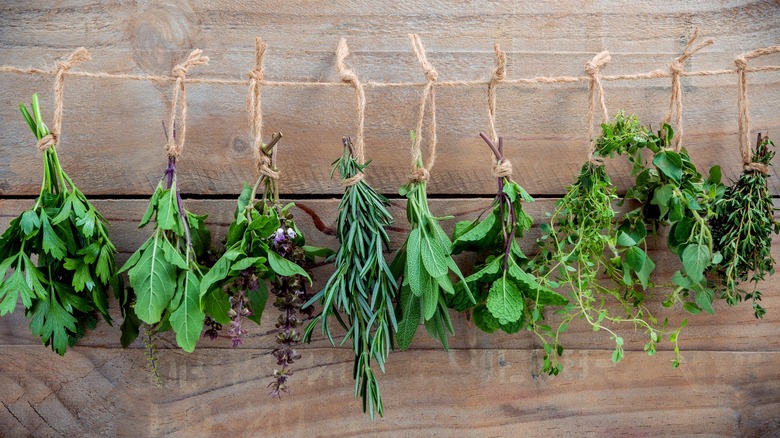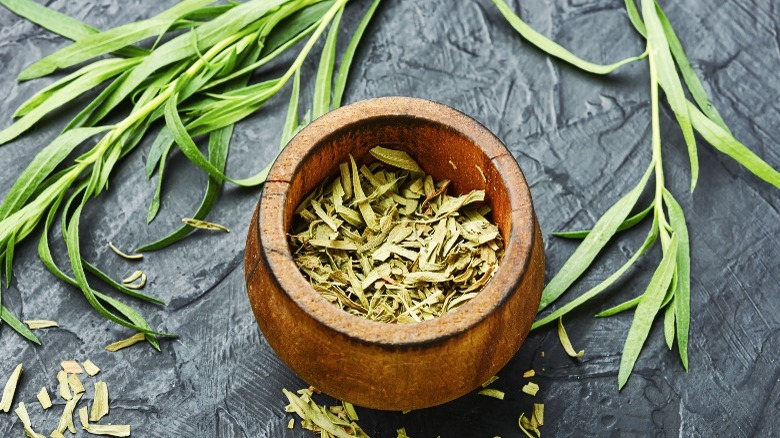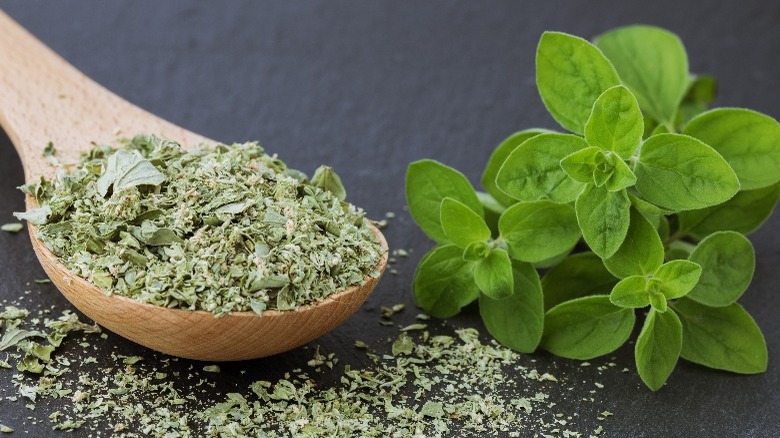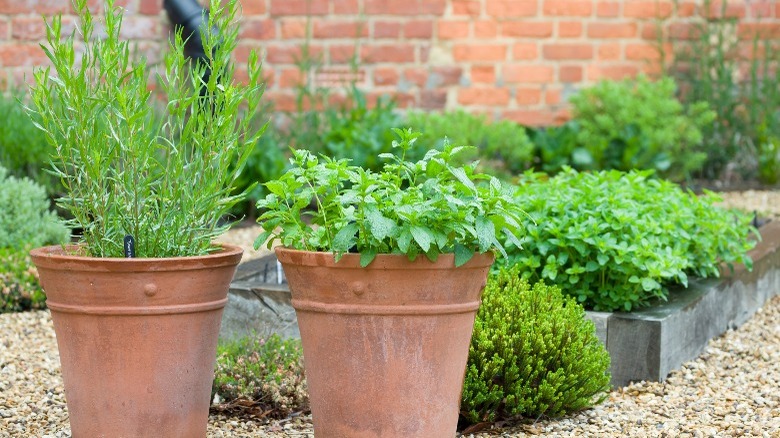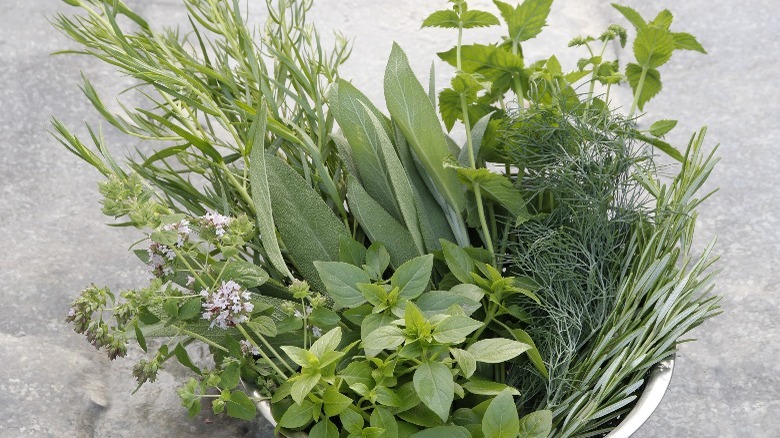Oregano Vs. Tarragon: Can You Substitute One For The Other?
Keeping your spices fully stocked can feel akin to Hercules fighting the Hydra – for every head he lopped off, two more grew in its place. When it comes to cooks and spices, it's the same principle but the opposite equation — as soon as you replenish one spice, you find you've run out of two others.
Think about it: When was the last time you had all of the spices you use at your disposal? We're not saying it can't happen, but most cooks know what it's like to turn to your spice cabinet for that indispensable jar of cinnamon, smoked paprika, or bay leaves only to find an empty vessel.
That's why being worth your salt when it comes to spice substitutions is a crucial skill in the kitchen, whether you're a professional chef, a home-cooking hotshot, or a busy parent that needed to get dinner on the table, like an hour ago. In addition to being able to swap your way out of culinary catastrophes, it's also an excellent way to put your own twist on a favorite dish.
So, where do you start expanding your substitution expertise? How about tarragon and oregano? Both tarragon and oregano are considered versatile spices that play well with other seasonings, but do they play well when impersonating one another?
What does tarragon taste like?
Tarragon (Artemisia dracunculus) hails from the Asteraceae or daisy family. A perennial herb (meaning it grows back each year as opposed to annual or biennial plants, which have shorter life spans) that is native to Central Asia and Europe, it became an essential ingredient in French and Italian cooking sometime in the late Middle Ages. With long and slender vibrant green leaves, the delicate flavor profile of fresh tarragon is a little hard to pinpoint. It has a mild, non-intrusive licorice taste, kind of like anise, but with some sweetness and hints of citrus. In its dried form, the flavor is much stronger. A staple in French cooking, tarragon is an integral component in Béarnaise sauce and the classic fines herbes spice blend (along with parsley, chives, and chervil).
Used on or in everything from chicken, fish, and rabbit to sauces, omelets, and flavored vinegar, the French called it the "King of Herbs" because of its delicate flavor and ability to complement so many diverse foods. Often added at the end to finish a recipe, tarragon's mild anise-laced flavors are thought to transform a dish into something far more sophisticated and complex than without its addition.
What does Oregano taste like?
Like tarragon, oregano (Origanum vulgare) is also a perennial herb. Sometimes it gets confused with marjoram (also in the Organum genus) because common oregano can sometimes be referred to as wild marjoram and because they look somewhat similar — with both having green, oval-shaped leaves and small purple flowers. Native to the Mediterranean region (as well as western Asia and northern Africa), this fragrant plant from the Lamiaceae, or mint family, has been used by Greeks and Italians for thousands of years.
Making things a bit muddier is Mexican oregano. Mexican oregano isn't even in the same family of plants as the common Mediterranean variety. It's from the verbena family and has a somewhat different flavor profile — with more citrusy, grassy notes. Common oregano (the version we'll be referring to throughout this article) is more bitter than tarragon, with a sharp but bright, peppery bite, strong aroma, hints of mint, and astringent camphor. Fresh oregano is more intense in flavor than its dried counterpart, but celebrity chef Ina Garten notes on her show that to maximize the flavor, all you need to do is rub it between your palms.
Used extensively in Italian food preparation, oregano is probably best known for sprinkling on pizza, though it's a staple in all Mediterranean cooking, seasoning a vast array of foods from lamb souvlaki, roasted chicken, and huevos rancheros to tomato-based sauces, chili, salad dressings, and pasta.
Can oregano substitute for tarragon?
Technically, oregano is similar enough that it can substitute for tarragon (though fresh is preferable in this instance, as dried oregano will add a level of bitterness that tarragon just doesn't have). Of course, you'll miss out on the magic that most reach for the tarragon for: The mildly sweet licorice/anise notes it imparts. This is fine if you're not a big licorice fan, but if you really want to mimic tarragon as closely as you can, there are some better options than oregano.
American food journalist and author Mark Bittman recommends (via Medium) subbing mint, chives, or chervil. While Spiceography cautions against subbing fresh tarragon with dried, noting that the difference in flavors between dry and fresh are significant enough to leave some with a bad taste in your mouth. Instead, try other substitutions such as fennel, anise seed, and basil in place of fresh tarragon. Oregano, marjoram, and rosemary can be used in dried applications.
Can tarragon substitute for oregano?
So, does tarragon fair any better in taking the place of oregano than oregano does in impersonating tarragon? While the answer is yes, it's not generally considered the best substitute. Marjoram, which is in the same family as oregano and tastes the most similar to it (just milder with added floral notes), makes a good choice. Italian seasoning is an excellent option since it contains oregano and some of its most popular substitutes (thyme, rosemary, marjoram, and basil), and it's one that many cooks readily have in their spice cabinet. Two herbs found in Italian seasoning also work in a pinch: thyme and basil. Use basil if you want to mimic some of the mild anise-sweetness in tarragon and thyme if you'd like a more subtle stand-in that hits the lightly mint and citrus notes these herbs have in common. Finally, there's sage, which, like oregano, works well with other spices and can handle long cook times. Just remember to use fresh sage if you want the most flavor.
Learning how to make substitutions is important when it comes to cooking. The most adept chefs can pivot at a moment's notice, improvising a whole meal in a kitchen that appears nearly empty to most. Regarding people asking him about substitutions, Bittman explains (via Medium), "...really they're requesting permission to ignore or defy parts of a recipe. My answer, 99.9 percent of the time, is 'Go for it!'"
